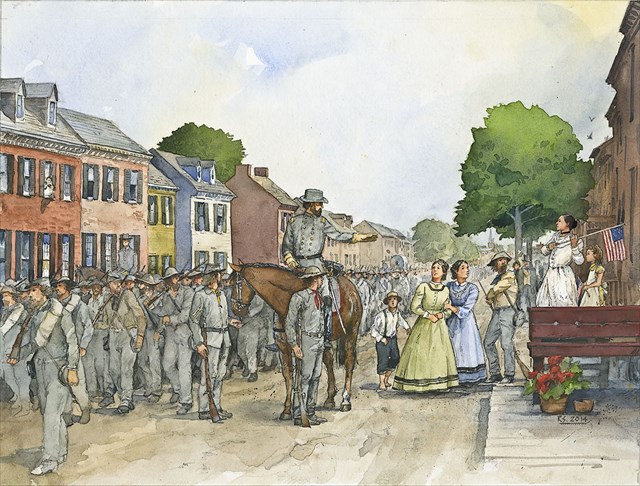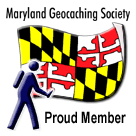This cache will be archived the week of August 25 - thank you to everyone who found it! Keep an eye out for the Heritage Area's new GeoTour, launching Sept. 19, 2025 and we hope you can attend our kickoff event in Westminster, more information about the event at https://www.geocaching.com/geocache/GCBB7KD.
The Heart of the Civil War Heritage Area (HCWHA) is an area rich in history, covering portions of Carroll, Frederick and Washington Counties. It is located just below the Mason-Dixon Line, generally viewed as the dividing line between North and South, and above the Potomac River. With one foot in the north, and one foot in the south, the story of the Civil War can be told nowhere better than in this part of Maryland.
No state experienced the Civil War quite like Maryland. Residents of this border state contributed significant resources to both sides of the war effort. Although large portions of the state’s economy relied upon slavery, Maryland lawmakers did not vote to secede from the Union at the outset of the war—though many did not have the opportunity to vote, as they were detained by the federal government because of suspected Confederate sympathies.
Between 1861 and 1865, the Civil War impacted nearly every Maryland resident. Some families faced financial ruin after troops ravaged their land. Thousands of fathers, sons and brothers became casualties of war. For enslaved Marylanders, the conflict ultimately brought about freedom as the new state constitution of November 1864 abolished the practice.
Marylanders witnessed three major military movements during the Civil War: the Maryland (also known as Antietam) Campaign in the fall of 1862, the Gettysburg Campaign in the summer of 1863, and the march to Washington led by Jubal Early in the summer of 1864. Geocachers can visit significant sites from each of these three operations on the Heart of the Civil War GeoTrail.
The mission of the Heart of the Civil War Heritage Area is to promote the stewardship of our historic, cultural, and natural Civil War resources; encourage superior visitor experiences; and stimulate tourism, economic prosperity, and educational development, thereby improving the quality of life in our community for the benefit of both residents and visitors.
The Heart of the Civil War Heritage Area Geotrail launched October 1st, 2016 with 15 geocaches within Maryland's Carroll, Frederick, and Washington Counties. A trackable geocoin will be awarded to the first 200 geocachers, (while supplies last), who find the locations of at least 13 HCWHA caches. To be eligible for the coin, geocachers must download a passport from the Heart of the Civil War website, and record the code word from at least 13 HCWHA geocaches. Geocachers may have their passports validated in person at the Newcomer House at Antietam National Battlefield or at the Visitor Centers in Westminster, Frederick, or Hagerstown. Please refer to the passport for Visitor Center hours and complete validation instructions.
Please note following change. A free prize will still be given to a geocacher who goes to at least 13 HCWHA geocaches and records the code in each of the geocaches on their passport. In addition, geocachers may purchase a trackable Geocoin for $10 at one of the following locations: Frederick Visitor Center, Hagerstown-Washington County Visitor Welcome Center, or Antietam Museum Store. Each of these locations will verify passports by mail and send a coin for a modest handling fee. Call for more information.
Participating in the HCWHA geotrail is fun and we hope that many people join in. However, it is not a requirement for logging your find on this cache once you find the container.

This location on West Patrick Street—also known as the National Road—in the Frederick Historic District is a perfect place to examine the divided loyalties of Marylanders in the Civil War.
Frederick served as an important crossroads of commerce and transportation in Maryland’s piedmont region long before European settlers arrived. American Indians of the Piscataway, Seneca and Tuscarora tribes of the Iroquois Confederation hunted in the area between Catoctin Mountain and the Monocacy River. Irish-born politician and land speculator Daniel Dulany laid out “Frederick Town” in 1745 and German immigrants soon formed a small, mostly agricultural community around Carroll Creek. During the Revolutionary War, a regiment of Hessian soldiers (Germans contracted to fight on behalf of the British government) garrisoned in barracks which stand today as part of the Maryland School for the Deaf campus. Frederick in the early 19th century grew into a bustling market and judicial center as the county seat. In late April 1861, the town briefly became Maryland’s capital for a “Special Session” of the General Assembly to vote upon secession.
September 1862 marked the first time in the Civil War that a major Southern army crossed the Potomac River. Robert E. Lee marched his Army of Northern Virginia out of his home state just east of the Blue Ridge Mountains and came to a stop in the City of Frederick. This strategic position meant that his army was just two days away from the important political centers of Baltimore and Washington, D.C. Many residents of southern Frederick County, between the Potomac River and the City of Frederick, harbored Confederate sympathies and greeted Lee’s men as liberators. Once the army arrived in town, however, most civilians viewed them as unwelcome invaders.
Frederick residents demonstrated their loyalty to the Union cause in a variety of forms. One display of patriotism during the Confederates’ 1862 occupation of Frederick was mythologized by the abolitionist John Greenleaf Whittier in his 1863 poem, “The Ballad of Barbara Frietchie.” He wrote of an elderly woman, “bravest of all in Frederick town,” who waved an American flag from her window as Stonewall Jackson’s troops marched below. “Shoot, if you must, this old gray head/But spare your country’s flag,” Whittier wrote in lines memorized by generations of school children.
Although Barbara Fritchie did live in Frederick at that time, historians believe the actions that inspired the famous story were in fact performed by another Unionist heroine and neighbor named Mary Quantrill. A school teacher, the 38-year-old Quantrill lived and taught near this location along the National Road. Quantrill and other eyewitnesses claimed throughout her life that it was she and her pupils who displayed Union flags from her porch on the morning of September 10, 1862.
Learn more about the county’s most outspoken Unionists and Confederates by visiting the Historical Society of Frederick County, the National Museum of Civil War Medicine, and the Maryland Room at the C. Burr Artz Library.


Thanks to the following members of the Maryland Geocaching Society in placing the hides for this Geotrail: deepdish23, GeoAPPs, lpyankeefan, Phos4s, and ZombieHNTR.